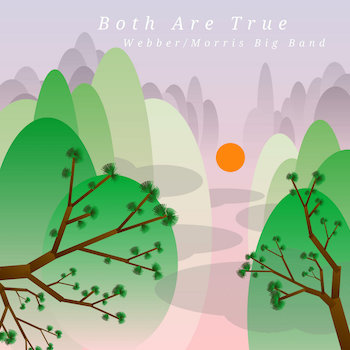Jazz CD Review: “Both Are True” — A Big Band Chock Full of the Unexpected
By Michael Ullman
What strikes this listener most is the writing’s disjointedly distinctive — sometimes unfathomable — sounds and textures, as well as the music’s unpredictable flow.
Both Are True, Webber/Morris Big Band. Greenleaf Music
 In 2015, saxophonist Anna Webber made a recording called Refraction. In 2016 she released another, called Binary. It is obvious that this is a musician who likes looking at both sides of a question: hence the new album, Both Are True, co-led with tenor saxophonist Angela Morris. The song titles on the recording suggest a concern with mirroring and bouncing back — toying about with reflections literal and figurative. The disc include the tracks “Climbing on Mirrors,” “Rebonds,” and “Reverses,” as well as two duets that are simply called “Duo” and “Duo 2.” The leaders-composers take turns conducting and performing. What strikes this listener most is the writing’s disjointedly distinctive — sometimes unfathomable — sounds and textures, as well as the music’s unpredictable flow, its carefully constructed sections filled with odd divagations.
In 2015, saxophonist Anna Webber made a recording called Refraction. In 2016 she released another, called Binary. It is obvious that this is a musician who likes looking at both sides of a question: hence the new album, Both Are True, co-led with tenor saxophonist Angela Morris. The song titles on the recording suggest a concern with mirroring and bouncing back — toying about with reflections literal and figurative. The disc include the tracks “Climbing on Mirrors,” “Rebonds,” and “Reverses,” as well as two duets that are simply called “Duo” and “Duo 2.” The leaders-composers take turns conducting and performing. What strikes this listener most is the writing’s disjointedly distinctive — sometimes unfathomable — sounds and textures, as well as the music’s unpredictable flow, its carefully constructed sections filled with odd divagations.
This outing features an extra-large band: 19 pieces, including Morris and Webber. (There are four trombones!) The opening number, “Climbing on Mirrors,” begins with a monotone, three note phrase from a saxophone, which the other horns take up and elaborate on via different pitches: periodically they are joined by a sub-group playing a falling, two-note phrase. Then everything becomes more and more intense and the repetitions come more rapidly…until suddenly the bottom falls out and the whole thing grinds to a temporary halt. That’s just the beginning. Next the whole band swings into the earlier obsessive phrases and it sounds grand. All of this fury turns out to be an introduction to a languorous alto saxophone solo by Charlotte Greve. Rather unexpectedly, in the midst of that solo, as the background empties out, a suggestion of swing arises. When the band returns it proffers, as a group, some impressive chords whose precise identity, as in some of the orchestral work of Ellington, are hard to unravel. The intensification recurs, and then there’s a passage that initially involves bass, drums, and vibes.
Following the opening comes the first of two seemingly wholly improvised duets between the two leaders on saxophone. The first is made up of straightforward tenor sounds; the second kicks off with some quietly played shrieks. The engaging title cut, “Both are True” begins with a confident series of phrases from oddly assorted horns throughout the rhythm section. But, as in the earlier piece, this blithe beginning moves into mysterious territory; various reeds play anxiously mumbling phrases over held notes by the brass. Drummer Jeff Davis should be given credit for his ability to whip up a wacky kind of swing — he also supplies a series of appropriately dramatic clicks and clacks.

Anna Webber (r) and Angela Morris (l). Photo: courtesy of the artists.
“Foggy Valley,” on the other hand, begins quietly with someone playing into (I believe) a saxophone mouthpiece. Then various whispering sounds come along, joined by deep interjections from, I am guessing, a bass clarinet and bass trombone. These enigmatic sonics are unlike anything I have heard on record before. Morris solos on this, her composition, but the monologue is designed to evoke eerie textures rather than to display her instrumental prowess. Even “It Rolled Right Down,” with its whimsical opening, meditates on duality with a touch of mystery. The ambitious compositions on Both Are True set out to exploit both small band and large orchestra possibilities: the big ensemble often reflects on material that has already been presented by the smaller groups. In the case of “It Rolled Right Down,” the theme for the big band emerges from a few bare suggestions supplied by a cluster of instruments. As the piece continues rolling, a clarinet soloist holds a conversation with a bass trombone and then finds itself fighting for its life when confronted with the rest of the ensemble.
The disc ends with “Reverses.” The notes credit poet Maya Angelou with the lyrics, but the only vocals we hear are (to my ears) incomprehensible comments by underrecorded voices — after the music has stopped. It’s the final surprise in a set chock full of the unexpected.
Michael Ullman studied classical clarinet and was educated at Harvard, the University of Chicago, and the U. of Michigan, from which he received a PhD in English. The author or co-author of two books on jazz, he has written on jazz and classical music for the Atlantic Monthly, New Republic, High Fidelity, Stereophile, Boston Phoenix, Boston Globe, and other venues. His articles on Dickens, Joyce, Kipling, and others have appeared in academic journals. For over 20 years, he has written a bi-monthly jazz column for Fanfare Magazine, for which he also reviews classical music. At Tufts University, he teaches mostly modernist writers in the English Department and jazz and blues history in the Music Department. He plays piano badly.
